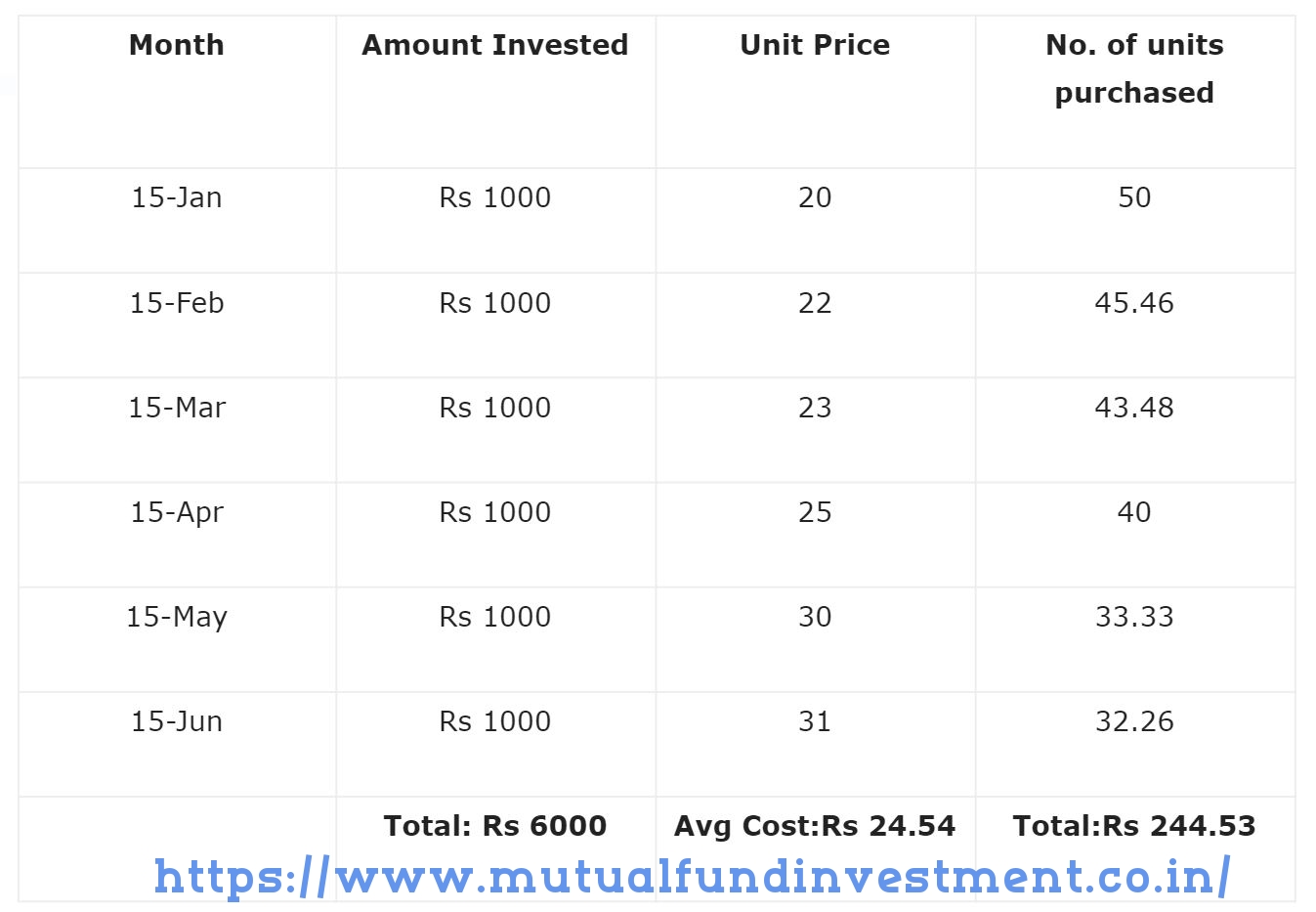Mutual funds has 2 option to invest, lump sum and SIP mode. SIP mode offers you to invest monthly fixed amount in your selected mutual funds. SIPs are a psychological tool of discipline. By nature, investors are tempted to invest more when the market is racing and stop investing altogether when it is falling. SIPs automate the entire investment process and detach sentiment from investing as well as market condition. Rupee Cost Averaging is an investment technique followed in mutual funds investments.
Mutual funds investor invests regular fixed amount monthly in a mutual fund scheme. Fixed amount in regular interval, more units are bought when the market price of shares is low and lesser units are bought when the price is high. Through this mechanism, the investment risk is spread across market movements.
Buy more mutual funds unit in case market down.
Buy less mutual funds unit in case market is up.
With rupee cost averaging, you can take advantage of the market highs and lows for your benefit. By making a fixed amount of investments every month through instruments like mutual funds, you can average out the value of each unit.
Consider an example: John invests Rs 1,000 each month in a SIP of an equity mutual fund. Markets are volatile for a particular period and goes for up and down. His investments would look like below.

The SIP method of mutual funds works on the principle of rupee cost averaging. It helps mitigate the “timing” factor and if you invest regularly, irrespective of the market level, it helps you earn higher potential returns in longer term.
It is important to understand that rupee cost averaging for mutual funds long-term strategy
Getting started with mutual funds:
- Decide on the amount you can invest on a regular and long-term basis.
- Select an investment you want to hold for the long-term. Equity mutual fund or Index mutual funds.
-
- Axis Focused 25 Growth Direct Plan
- Axis Long Term Equity Growth Direct Plan
- SBI Small Cap Growth Direct Plan
- Aditya Birla Sun Life India Gennext Growth Direct Plan
- Mirae Asset Emerging Bluechip Growth Direct Plan
- Canara Robeco Emerging Equities Growth Direct Plan
- Invesco India Contra Growth Direct Plan
- IDBI Equity Advantage Growth Direct Plan
- Login to mutual funds aggregator platforms such as Zerodha, PayTM money, Kuvera to begin your mutual funds investment.
- Invest at regular intervals (weekly, monthly or quarterly)
Rupee Cost Averaging works investors who do not have time to monitor the economic market
Benefits Of Rupee Cost Averaging :
- Get maximum value for invested money in longer term.
- There is no tension due to market condition.
- Balances the volatility associated with the market
- Flexible and offers a better opportunity for wealth creation
Rupee cost averaging in direct stock market:
In Rupee cost averaging works in stock market as well. In case market is down, do not invest all your money on particular day. Split your investment to 5 days and invest daily on stock market. In case you are planning to invest 10 lakhs rupees in stocks, invest 2 lakhs each day or each week. It would spread over the investment period and utilize the market condition without huge loss.
In case you want to invest 10 lakhs to buy ITC stocks. Buy by following Rupee cost averaging. ITC stock prices as below,
Jan 14, 243 rupees. ( 2 Lakhs investment on ITC)
Jan 30, 234 rupees. ( 2 Lakhs investment on ITC)
Feb 14, 207 rupees. ( 2 Lakhs investment on ITC)
Feb 28, 197 rupees. ( 2 Lakhs investment on ITC)
Mar 11, 176 rupees. ( 2 Lakhs investment on ITC)
In case you invested all your 10 lakhs on Jan 14 or Jan 30, you may be missed the opportunity to buy the ITC at lowest price when it was 176. So spread your investment to different weeks to minimize the impact of market condition. Don’t be greedy in market condition.
Follow Rupee Cost Averaging approach to reap maximum benefit and minimize the impact.
Rupee Cost Averaging works only for long term investment and not for day trading. I have taken example of ITC to explain the impact of rupees cost averaging. You can do same for your investment and be smart.
Freshers or first time taxpayers? Knowing 80C would save you 10000 rupees.
At age of 27, why fear to manage 7 mutual funds? It is easy…!!!





